|

 Up
Up 
 A Turn for
A Turn for
the Purse 
(You are here.)



  Need
to Need
to
find your
bearings?
Try
these
navigation aids:
If
this is your first
visit, please stop by:
Something
to share?
Please:



|
|
Available in Française, Español, Português, Deutsch, Россию,
中文,
日本, and others.
 he
French were in the air and in the news in the spring of 1908. Gabriel
Voison was manufacturing airplanes made to order. He had begun in 1905,
manufacturing a semi-successful floatplane glider for Ernest
Archdeacon and another less successful glider for Louis Bleriot.
Despite the failure of their first collaboration, he formed a brief
partnership with Bleriot and built two more airplanes with him. The first,
called the Bleriot III, had elliptical wings and tail. The
partners tested it both as a glider and a powered airplane, both on
land and water, but could not get it to fly. So they rebuilt it with
standard wings in front and elliptical tail – the Bleriot IV
– but it still remained earthbound. Voisin blamed its
failure on Bleriot's unusual ideas and his erratic approach to
aeronautical engineering. he
French were in the air and in the news in the spring of 1908. Gabriel
Voison was manufacturing airplanes made to order. He had begun in 1905,
manufacturing a semi-successful floatplane glider for Ernest
Archdeacon and another less successful glider for Louis Bleriot.
Despite the failure of their first collaboration, he formed a brief
partnership with Bleriot and built two more airplanes with him. The first,
called the Bleriot III, had elliptical wings and tail. The
partners tested it both as a glider and a powered airplane, both on
land and water, but could not get it to fly. So they rebuilt it with
standard wings in front and elliptical tail – the Bleriot IV
– but it still remained earthbound. Voisin blamed its
failure on Bleriot's unusual ideas and his erratic approach to
aeronautical engineering.
So Voison left Bleriot to his own devices and in 1906 teamed up with his
brother Charles to start Appareils d'Aviation Les Frères Voisin. The
brothers established the first airplane factory in the world
at Billancourt, France, making any design that a customer wanted. A
Russian prince ordered a craft with a propeller in the shape of a spiral
staircase. A Dutchman paid for a set of wings grafted onto a "kind of
car" – it failed to fly. But their most successful aircraft were
those they designed themselves. In March 1907, they decided to improve
upon the float-glider that Gabriel had made for Archdeacon. They built a
Chanute-style glider with biplane wings and a box-kite tail. The
craft flew reasonably well, and this became the jumping-off point for a
line of increasingly airworthy aircraft.
Later in 1907, the Voisons made an airplane for Leon Delagrange in the
same style as this glider, but added an elevator in front, similar to
the standard Wright configuration or "de type Wright.. To push the aircraft through the air, they
mounted a
50-horsepower Antoinette engine and a propeller on the lower wing. Although it had no roll control, Delagrange was able
to make short hops of up to 500 meters (1650 feet). As such, the Voisin-Delagrange
I was the first European airplane to best the Wright's first powered
flights of 1903.
Soon after, Delagrange brought Henri Farman, the son of a prominent
British journalist and a French woman, to the Voison aircraft plant.
Farman was a painter, cyclist, and automobile racer who had been bitten by
the aviation bug. He first took to the air in a home-built Chanute-Herring
glider, then on Delagrange's advice approached the Voison brothers for something with power.
Farman carefully looked over the plans Gabriel and Charles laid before
him, then ordered a Voison aircraft with a few minor – but important –
modifications.
Farman began to fly the Voison-Farman I on September 30, 1907,
making a modest hop of just 30 meters (100 feet). Thereafter, he began to
stretch the distance little by little. He also modified the airplane as he
gained more flying experience, reducing the
size of the tail, and adjusting the dihedral angle of the wings, all to
reduce drag, improve stability, and make the airplane more maneuverable.
However, even in its final form, it had no roll control – Farman made do
with an elevator and rudder only.
On 26 October 1907, Farman made a flight of 712 meters (2,350 feet)
and won a second Archdeacon Cup. This was a prize that Ernest
Archdeacon had offered to the aviator who made the longest flight during
the year. On 19 November1907, Farman made a run at the Grand Prix de
Aviation, the prize offered by Ernest Archdeacon and Henry Deutsch
de la Meurthe for the first closed-circuit flight of over one kilometer.
However, Farman didn't quite complete the circular course. Orville
Wright, who was still in Europe, witnessed Farman's attempt. When asked by
the reporters for a comment on the rapid progress of French aviation, he
was cool and criticized the French airplane's control system only obliquely.
"Time will show whether the methods of control used in the Farman
machine are adequate to meet the conditions encountered in windy
weather," he was quoted. Privately, he wrote to Chanute that the
French were busy but "we see no indication of a practical machine in
the near future."
Archdeacon, ever the Wright detractor, took affront at Orville's
attitude. "The famous Wright brothers may claim all they wish,"
he blustered. "If it were true – and I doubt it more and more –
that they were the first to fly through the air, they will not have the
glory…The first authentic experiments in powered aviation have
taken place in France; they will progress in France; and the…Wrights
will, I am sure, be beaten by us as well before they will have decided to
show their phantom machine."
On 13 January 1908, Farman took off again in pursuit of the Grand
Prix de Aviation and its 50,000 franc purse. He made a flying start,
crossing the starting poles about 13 feet (4 meters) off the ground. He
flew straight out for about 1640 feet (500 meters), slowly climbing to 40
feet (12 meters), then made a wide, flat turn, using rudder alone to slide around the
marker. He came back and made another flat turn, crossed the point at which he
started, and landed gently. The entire flight lasted 28 seconds, and
covered the prescribed kilometer. It didn't matter that his turns were
clumsy and he was in constant danger of losing control of the Voison-Farman
I. Henri Farman had won the most coveted prize in aviation, and for
the moment – as far as the French were concerned – the Wright brothers
were put in their place.
|
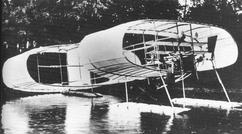
The 1906 Bleriot III was a radical departure
from any previous aircraft design and would not fly at all, either as a
glider or a powered airplane.
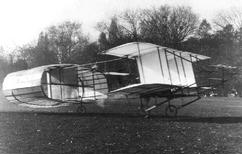
Voison rebuilt the Bleriot III,
replacing the front elliptical wings with something more traditional,
but it dodn't help. The aircraft – now called the
Bleriot IV –
would not fly.
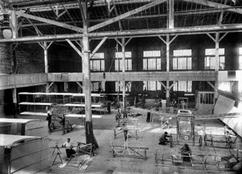
The Voison brothers aircraft factory – the
beginning of the aviation industry.
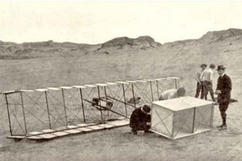
The Voison brothers' 1907 glider – Chanute wings with a Hargrave tail.
The success of this aircraft would influence all future Voison designs.

The 1907 Voison-Delagrange
I was the first European airplane to outdistance the 1903
Wright Flyer I.
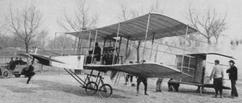
The 1907 Voison-Farman getting ready to fly. This
aircraft flew nearly half a mile with
no roll control. Orville
Wright, who was in France at the time, was unimpressed with its
performance.
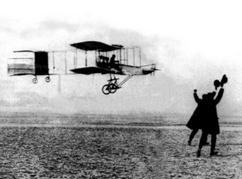
Henri Farman flies the first circle in Europe in
1908, using his rudder and elevator to make wide, flat turns.
|